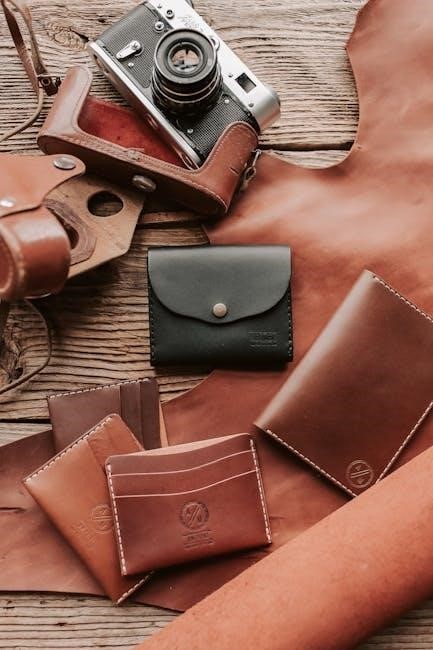Leatherworking in Cataclysm Classic is a crafting profession that allows players to create leather and mail armor, enhancing their character’s gear and providing self-sufficiency. It pairs seamlessly with Skinning, enabling efficient material gathering. This profession is ideal for those seeking to craft durable armor, stand out with unique gear, and optimize their in-game economy through cost-effective crafting strategies.
Why Choose Leatherworking in Cataclysm Classic?
Leatherworking is a versatile and rewarding profession in Cataclysm Classic, offering self-sufficiency by crafting your own leather and mail armor. It pairs perfectly with Skinning, allowing you to gather materials directly from enemies. This profession is ideal for players seeking durable gear, as crafted armor often provides excellent durability and stat bonuses. Additionally, Leatherworking enables you to create items for sale on the Auction House, making it a profitable skill for gold-making. With its straightforward leveling process and high demand for crafted gear, Leatherworking stands out as a practical and lucrative choice for both casual and competitive players in Cataclysm Classic.
Synergy with Skinning and Other Professions

Leatherworking in Cataclysm Classic is deeply intertwined with Skinning, as it relies heavily on the raw materials obtained from skinned creatures. This synergy ensures a steady supply of hides and scraps, reducing reliance on the Auction House; Additionally, pairing Leatherworking with other professions like Herbalism or Alchemy can enhance its benefits, allowing for resource sharing and crafting complementary items. For instance, using herbs from Herbalism to create potions that boost crafting efficiency or combining with Alchemy for stat-enhancing consumables. This multi-profession approach optimizes resource utilization, making Leatherworking not only self-sufficient but also a key component of a well-rounded crafting network in Cataclysm Classic.

Leatherworking Leveling Guide: 1-525
Master Leatherworking from 1 to 525 with this comprehensive guide, focusing on efficient leveling, cost-effective crafting, and optimal material usage in Cataclysm Classic.
Materials and Gear Required for Leveling
To level Leatherworking efficiently in Cataclysm Classic, you’ll need a steady supply of leather materials. Start with Ruined Leather Scraps and Light Leather, which are essential for crafting early items. As you progress, Heavy Leather, Thick Leather, and Cured Heavy Hide become crucial. Don’t forget Coarse Thread, a necessary reagent for most recipes. Gather these materials through Skinning or purchase them from the Auction House. Having a surplus ensures uninterrupted crafting and minimizes delays. Plan ahead by stockpiling rare materials like Dragonbone Leather for high-level recipes. Balancing material quantity and quality is key to efficient leveling and cost-effectiveness.
Step-by-Step Leveling Process: Recipes and Strategies
Leveling Leatherworking in Cataclysm Classic requires a strategic approach to maximize efficiency. Begin by crafting Light Leather items like Light Leather Pants and Light Leather Tunic up to skill level 50. Transition to Heavy Leather recipes such as Heavy Leather Belt and Heavy Leather Pants to reach level 100. At higher levels, focus on crafting Thick Leather gear like Thick Leather Pants and Thick Leather Belt. Use Coarse Thread to enhance durability. Optimize by alternating between patterns to reduce material waste. Monitor your progress and adjust recipes as skill levels increase, ensuring a smooth journey to 525. This method ensures steady skill gains and minimal material usage.
Optimizing Crafting for Efficiency and Cost-Effectiveness
To optimize your Leatherworking crafting, focus on planning your material usage and leveraging the Auction House. Prioritize recipes that provide the highest skill gain per material, such as Light Leather Pants and Heavy Leather Belt, to minimize waste. Use vendors to purchase essential supplies like Coarse Thread and Heavy Hides when needed. Avoid crafting items with low demand or high material costs unless necessary. Consider crafting in bulk for multiple skill levels to reduce downtime. Monitor Auction House prices to identify profitable patterns and timing for crafting. This strategic approach ensures you reach max level efficiently while minimizing expenses and maximizing gear utility.

Leatherworking Trainers and Recipes in Cataclysm

Leatherworking trainers are found in major cities like Stormwind and Orgrimmar. Key recipes include Light Leather, Dark Leather, and Heavy Leather goods, essential for crafting armor.
Locating Leatherworking Trainers in Azeroth
Leatherworking trainers are conveniently located in major cities across Azeroth, including Stormwind and Orgrimmar. In Stormwind, you can find Timothy Cobb near the trade district, while in Orgrimmar, Logan Darkbinder is situated in the Valley of Strength. Additional trainers are available in other key hubs like Dalaran and the Exodar. These trainers provide essential recipes and guidance to help you master the craft. Locating them is straightforward, as they are often near other profession trainers, making it easy to access their services. Ensure you check your profession tab regularly to unlock new recipes and specializations as you progress in skill level. This accessibility ensures a smooth progression in your Leatherworking journey.
Key Recipes for Crafting Leather and Mail Armor
Leatherworking in Cataclysm Classic offers pivotal recipes for crafting leather and mail armor, essential for enhancing your character’s gear. Recipes like Dragonbone Leg Reinforcements and Twilight Leg Armor are highly sought after for their durability and stat bonuses. These recipes require rare materials such as Dragonbone Leather and Heavy Savage Leather, often obtained through high-level dungeons or crafting. Other notable recipes include Barbaric Shoulders and Dark Leather Belt, which are cost-effective for leveling and provide excellent stats. These recipes not only aid in character progression but also allow for profitable crafting to supply the in-game economy. Mastering these recipes is crucial for both PvE and PvP success in Cataclysm Classic.
Specializations in Cataclysm Leatherworking
Cataclysm Leatherworking offers three distinct specializations: Dragonstayer, Elemental, and Tribal, each providing unique bonuses tailored to specific playstyles, enhancing armor and character performance.
Choosing the Right Specialization for Your Playstyle

In Cataclysm Leatherworking, selecting the right specialization depends on your character’s role and playstyle. Dragonstayer is ideal for tanking classes, offering increased stamina and armor. Elemental suits casters and healers, providing spell power and haste. Tribal is perfect for melee DPS, boosting attack power and critical strike. Each specialization enhances specific stats, so consider your class and role to maximize benefits. For example, a Paladin tank would benefit from Dragonstayer, while a Shaman healer might prefer Elemental. Experiment with specializations to find the best fit for your character’s needs and optimize performance in raids, dungeons, and PvP scenarios.

Benefits of Specializations: Dragonstayer, Elemental, and Tribal

Each Leatherworking specialization in Cataclysm Classic offers unique benefits tailored to specific roles. Dragonstayer enhances stamina and armor, ideal for tanks and melee classes. Elemental boosts spell power and haste, benefiting casters and healers. Tribal increases attack power and critical strike, perfect for melee DPS. These specializations allow players to optimize their gear for their character’s role, enhancing performance in raids, dungeons, and PvP. The bonuses provided by each specialization are impactful, making them a crucial choice for players seeking to maximize their effectiveness in combat. By aligning your specialization with your playstyle, you can achieve superior results and excel in your preferred role.

Gold-Making Strategies with Leatherworking
Leatherworking offers significant gold-making potential by crafting high-demand gear. Focus on creating items with consistent demand, using Auction House data to identify profitable recipes. Balance quality and cost-effectiveness to maximize profits while adapting to market trends and player needs.
Crafting High-Demand Gear for the Auction House
Crafting high-demand gear is a cornerstone of maximizing gold income with Leatherworking. Identify items like belts, gloves, and boots, which are consistently sought after by players. Use Auction House data to determine profitability and focus on recipes with low material costs but high demand. Crafting multiple variants ensures you cater to different player needs and preferences. Balance quality and affordability to attract both casual players and progression raiders. Stay updated on market trends and adapt your crafting list accordingly. Timing your auctions during peak hours, such as weekends or raid resets, can significantly boost sales. Specializing in niche markets, like PvP or leveling gear, can also yield higher profits. By strategically crafting and listing items, you can establish a steady gold income stream.
Advanced Tips for Maximizing Profit
To maximize profit with Leatherworking, adopt a data-driven approach by analyzing Auction House trends and demand fluctuations. Utilize addons like Tycoon or Auctionator to track market prices and identify underserved niches. Prioritize crafting items with high demand and low competition, such as raid or PvP gear. Timing is crucial—post items during peak hours when players are most active. Diversify your inventory to cater to different playstyles and level ranges. Additionally, consider crafting materials like thread or enchanted leather to sell to other crafters. Maintain a balance between crafting for immediate profit and stockpiling materials for future opportunities. Regularly review your crafting costs and adjust prices dynamically to stay competitive and maximize gold income.

